#vol. xxix
Explore tagged Tumblr posts
Text
Occupying an interstitial position between different continents [...], [t]his position as a space-between-spaces makes the Maghrib a hub [...]. [I]nvestigate the location of the Maghrib beyond the dominant binary of Arab vs. Francophone, the much-critiqued idea of the Sahara as a barrier, or the assumption of the Maghrib as an insular space. [...] [T]he Maghrib was a revolutionary concept [...]. [T]he idea of the Maghrib was rooted in anticolonial thought, one which the machinations of colonial power and exigencies of postcolonial state building and border disagreements have stalled ever since. [...]
Tamazgha -- as indigenous Amazigh activists have chosen to call North Africa since the 1990s -- was populated by Amazigh populations of Christian and Jewish faiths. [...] These dynamics, however, neither eliminated Amazigh language and culture nor drove out the sizable Jewish populations that shared this Judeo-Islamic space. Rather, it was nineteenth- and twentieth-century European colonialism [...]. Governments have either entirely silenced Amazigh language and culture, as was the case in Libya and Tunisia, or actively repressed them, as was the case in Algeria and Morocco.
Nevertheless, a vibrant Amazigh Cultural Movement (ACM) has struggled to re-Amazighize the Maghrib by inventing traditions and refiguring toponymies.
---
Tamazgha, which this ACM defines as extending from the Siwa Oasis in Egypt to the Canary Islands in the Atlantic Ocean, has replaced both “North Africa” and “the Maghrib” in activist nomenclature.
Activists have thus reinscribed this consciousness of “al-dath al-amazighiyya” (the Amazigh self/subjectivity) in public spaces as well as in the markers of Maghribi geographies.
Gone are the days when Amazigh people could be simply erased from the cartography of their native lands. Tamazight has acquired a constitutional status in Morocco and an official one in Algeria. Its speakers are working to have it recognized in Libya and Tunisia. [...]
The ubiquity of the Tifinagh alphabet (the Tamazight script) and the proliferation of Tamazight literary and audiovisual production has created a new cultural reality. Across short stories, novels, film, and music, Amazigh creators are reinventing the Maghrib and reconciling it with its indigenous past. [...]
---
The rise of taskla Tamazight (Amazigh literature) and cultural production is the single most transformative literary development in the last thirty years of the Tamazghan intellectual movement. [...] Amazigh cultural producers are not just rehabilitating their mother tongue. They also rehabilitate an erased geography, a sense of indigeneity, and the relation-ship between space and people.
Shamal Iiriqiyya (North Africa in Arabic), Afrique du Nord (North Africa in French), or the Maghrib, are geographical and political appellations superimposed on the region [...]. Alternatively, Tamazgha is a politically conscious name that is from the same root as Tamazight.
Tamazgha means the land of the indigenous Imazighen, which reconfigures space, revisits history, and questions accepted toponymies. [...]
---
The plurality of the Maghrib and its multilingualism will undoubtably acquire a different meaning when we read them from the perspective of indigenous authors in Amazigh languages. Immersion in the discourses of the ACM reveals [...] foundational ideas like le Maghrib pluriel (the plural Maghrib) [...]. These organizations seeded and then advocated the idea of “al-wahda fi al-tannawwu‘” (unity in diversity). [...]
Whether it is Algerian Kabyle musician Idir, the Moroccan band Izenzaren (Sun Rays), or Malian Tuareg band Tinariwin (Deserts), Amazigh melodies and poetry travel, cross boundaries, and reconnect Imazighen across the globe.
This “traveling Tamazgha” complicates the Maghrib’s location and invites a constant mapping and remapping of the space and its aesthetics.
---
Text by: Brahim El Guabli. ”Where is the Maghreb? Theorizing a Liminal Space.” Arab Studies Journal Vol. XXIX, No. 2. Fall 2021. [Bold emphasis and some paragraph breaks/contractions added by me.]
#the author is amazigh#tidalectics#archipelagic thinking#zomia and maghrib#geographic imaginaries#indigenous
34 notes
·
View notes
Text

Chapter XXIX: "Ignition" from Beneath the Armor, Volume I
FINAL CHAPTER OF VOL. I
Excerpt: "The heat coating her accent is mesmerizing. She shifts on the ground and re-arranges her legs, folding them on her other side. Her movement causes his eyes to drop, and he observes how her tanned legs, long dried from the fire’s warmth, appear exceptionally smooth. When he raises his gaze, he sees that the front of her black robe has parted a little more, revealing a few extra centimeters of precious cleavage. His mouth begins to feel parched, and he cannot tear his eyes away from her flawless complexion. How long has it been since he has seen this much skin on an attractive female?
"A long time.
"Too long, his primal needs agree in a deep growl that resonates throughout his body."
Read here: Beneath the Armor, Vol. I - Chapter 30 - SillyRomantic4Ever - The Mandalorian (TV) [Archive of Our Own]
#archive of our own#the mandalorian#mandalorian fanfic#star wars#mando's pov#wookiees#the shadowlands#gungi
0 notes
Text

Community Notes Vol 1.1
First they're sour, then they're sweet
above: SITE XXIX by Kevin Beasley
FROM THE SUBSTACK ANCIENT CLAY
They cannot handle the truth and always shoot me when I am the messenger. It is masochism at this point: I keep getting caught in wasting time pointing out anti-Black celebs and microcelebs in the art world. I am not a walking angry Black person trope; I do not come to "tear other Black people down," we all know platformed people of all races are anti-Black or enable anti-Blackness to some degree, but I guess I will continue to get demonized for not masking and saying aloud what people say in private now (but will say once one can gain clout on the scene for "finally" giving "voice to the voiceless.”)
Aged phrases like "voice to the voiceless" speak to the trend of Word or Text Art coming back in the 2020s Art; it is part 'art world finding another genre or medium that they "forgot" for a while' and part 'the art world needing another medium gentrify to center whiteness or shallow' by uplifting artists who use moderate to radical liberal phrases such as virtues, quotes from scholars/thinkers out of context or "ironic," cheesy adages. Slowly but surely, everyone wants their work to look like a dairy entry in oil paint or a TopSecret entry from a Yale MFA grad in several "ultra-contemporary" circles, and text artists from prey2k are trending (but most aren't references Black prey2k text artists; I can’t even think of a major group show or art book of Black text [open to suggestions!]). Everyone is trying to make "sincere," Live Journal-influenced, early blogging-inspired works when they can't even show basic empathy by wearing a mask during a surge that affects immunocompromised Black people the most, please. Everyone in the arts is choosing escapism and acting as if their empathies have run thin for (former, no more for me) Black whistleblowers like myself. That selfishness is an active choice people make because the current zeitgeist promotes rugged individualism through global anti-Black capitalism. This current stream of violence and information is not unique to our age, and those who came before us were just as aware of things that happened and never complained about "overconsumption" in society to deflect action or "capacity" when it came to combatting anti-Blackness or materially supporting Black whistleblowers. 'Black Joy' or 'nonblack Joy' is not resistance or counterculture. Many artists wanna be the people who say they are "not nice; they are kind." You are trying to be "authentic" through anti-Black capitalism and consumerism. So many artists dress the same now (Sambas, Margielas, Telfar, etc.) and make similar Deviant art-coded work, aka Art Black people made in high school for fun or Art from Black people outside the academy. They are trying to memeify 'Live, Laugh, Love,’ but like it as an "inside joke" because the early 2010s are already "on trend" in "ultra-contemporary Art right now. They will only put on Black word-centered Art in 2023 from Black people with majority nonblack friends when the Black artists who make the most moving and transformative work art or text art of our current times, not the artists with the most clout, should get the most support (but I am not repeating myself about how Art is not meritocracy.)
Light Art is having a moment now; stone art and small-scale metalwork (like the solder piece I saw during the last fair week) will trend soon. You can only do small-scale glass "at home," so glass Art takes longer than you would think to trend. Inkjet/image transfer/laser jet is everywhere; that's funny when you factor in that one major criticism from certain Art people about a bulk of my work is using images + image transfer as material for years. "All you do is print images you find online; that's not Art," and now everyone's printing and image transferring pixels and photos they find online. Everyone's making fabric or mixed media art books right now; calm down, nonblack Tumblrinas. The North remembers that you all looked down on cloth books or mixed media books from Black people just a few years ago. For example, some of y'all are basically Devin Morris's children; y'all are still playing catch to 3DOTzine and Devin's mixed media works on paper. Black artists doing craft center works drive all current art trends. (I would even put the nonBlack airbrush art alt bros in there because they all make gentrified versions of Black graffiti work over the years, but put it on canvas or linen.)
I told someone earlier today that I have avoided learning to use resin in my work for years because I believe resin is a cheap conceptual trick because most objects alone or collaged together look amazing in resin. Most artists do not use resin in poetic or graceful ways, and I was afraid of getting lumped in with other artists who use resin in uneventful ways. However, I was intimidated by this other medium I am currently working in and decided to learn resin this weekend instead because it seemed easier; it was easier. Equal parts solution A to solution B in a container, mix until it is not cloudy anymore, then use. In the future, I plan to incorporate resin, but as one component of many, probably never the main component (Silicone mat or parchment paper for work surface). After that little experiment, I moved into another medium, which will soon trend (like that recycled clothes piece from that trendy group show): mosaic.
There are several versions of mosaic; you need to prepare the surface you are working on, adhere (archival glue/museum glue or thin-set because it is tile adhesive that can take water and the outdoor elements) what you want to the substrate (surface of what you want to cover in mosaic), then cover whole project with grout mix then wipe down project with rags (or sponge only if needed, but I do not use sponge often) until clean then let dry and seal grout.
I am anti-gatekeeping art skillsets (email [email protected] with questions or concerns); I do not care if someone else learns how to make the Art I make; that does not threaten me. Copying should only annoy anyone if it comes from someone with more power than you or if there is no transformation with the 'copying' and you are left with only echoes of the source work or mirroring of the source artist with no substantial additions. I wanna see Black people get into mosaics like I have recently; the process is a beautiful way to "upcycle" materials in your practice. Community Notes will be in this format moving forward; I just want to make art and believe all Black people should get support, not just the few who will never risk calling anti-Blackness in Art past, present and future. Sending love to all this week before Art Month + NY Fashion Month begins.
1 note
·
View note
Text
Destiel Chronicles
(Vol. XXIX)
It was a love story from the very beginning.
Some issues
(7x18/7x20/7x22)
Hello my friend!!!! This is fantastic, we are two metas from season 8!! But don't rush!
Today is time to analyze the episode in which we met Charlie. And she played like a catalyzer for Bi!Dean in front of our eyes!
I want to say thanks to my friend @agusvedder she made the gifs and discussed the episodes with me! Thank you gorgeous! 😘💕💕
Okay, let's do this...
A little foreshadow for S8
This meta is gonna be short... But don't worry next one is really... Huge...
In episode 7x18 Party on Garth, we start the chapter with Dean talking with Meg by the phone about Cas.
DEAN (on phone) All right, well, call us if he wakes up or, you know, anything.
Yeah, fine.
Thanks for your help, Meg.
DEAN hangs up.
DEAN What a bitch.
SAM So, Cas is the same, then?
DEAN Yeah, down to the drool.
Okay, IDK if I'm thinking too much here but... Is Dean calling her too many times? Like... Why is Dean mad? Why is he saying what a bitch? After he said thanks for your help? I would love to think is not just because she's a demon but... Maybe Meg is so done Dean is calling everyday? And the report is always the same?
Yeah... I like to think Dean is calling Meg everyday asking for Castiel's condition, and Meg is like so fastidiously answering with the same boring report. Love this headcanon. No much evidence for this one, but ... Yeah... I'll take it.
What this episode has too, is a foreshadow for episode 8x07... Pay attention...
DEAN: Well then what, Sam? Is Bobby here, or not?
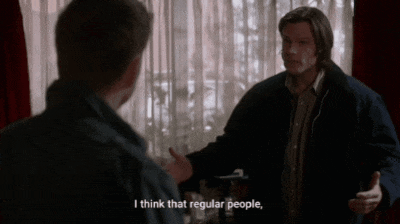
When is Dean gonna to see someone everywhere?? Yep... Dean is gonna see Cas everywhere in episode 8x07... Because he'll be missing him a lot.
Another foreshadow here involving Bobby, happens in episode 7x22 There will be blood.
When Bobby appears in the bathroom, behind Dean, and Dean saw him as a reflex on the mirror when he was there. Again... Is the same position Cas will have and Dean will have in episode 8x07 when he appears for the first time behind Dean after coming back from Purgatory.
Again, you can rewatch the scene and compare, FAMILY LOVE vs ROMANTIC LOVE.
Nothing to see here... Let's continue...
Charlie exposed Bi!Dean and the brothers parallel
When the brothers guided Charlie into her first 007 mission , they helped her with things they knew very well... And that's the parallel.. right there...
Look at Sammy and Charlie here...


Okay, Sammy uses an interest they have in common, Dean didn't know till now, but Sam loves Harry Potter, so he's about to use that example he knows very well, to help Charlie.
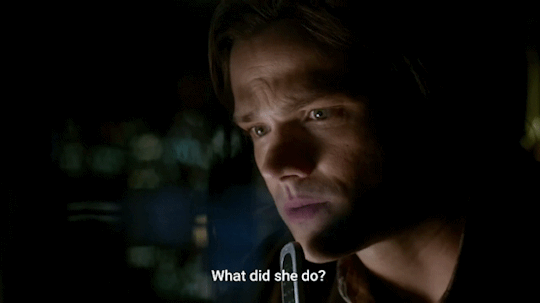

Good work here! Sammy had helped Charlie encouraging her with a Harry Potter's character. Needs together are powerful!
Now ... How could Dean help Charlie? What he could offer her? His hunting skills?, Nope... But with his flirting skills.. because he's an expert in that, like Sammy is about Harry Potter.
But not just flirting, but flirting with a guy.

First of all, when Charlie informed there was a male guard there, Dean and Sam didn't know she was lesbian. Dean tried to help her by asking her a basic question bases on his own experience... Eye Contact. And we know he knows very well about what he's talking about... Mostly because he'd experienced a lot of eye fucking with one very hot and male angel. So... He knows eye contact EYE FUCKING MOSTLY, is one of the most important things to know if the other guy has interest in you. And Dean knows Cas is very skilled too in eye fucking 😏🤣🤣

Dean thought it was easy if they had the eye contact thing, flirting is the next step. But he found a big obstacle there... Charlie is a lesbian. So... Dean, with his knowledge about flirting... He decided to help her with that.

Okay... Flirting with a guy... Not big deal... He does it all the time with CAS... 😏🤣

Well... What is this scene? Does the producers choose to put Dean and the guard face to face while Dean is flirting indirectly with him?
Look at Dean's face... He's really enjoying this 😏💕 Bi!Dean people!
To Conclude:
Episode 18 and episode 19 had elements that could be taking as foreshadow of episode 8x07, when CAS come back from Purgatory, using Bobby again as a parallel, as they used him in season 6, remember?
Charlie was the character that exposed Dean as bi, being she a lesbian, and we saw a wonderful parallel between two brothers using their skills: Sammy as a cute nerd with Harry Potter and Dean flirting with a guy and teaching about eye fucking/contact.
Okay! I hope you enjoy this! It was short as I said. C-u in the next and last chronicle about season 7!! 😘💞
Tagging @metafest @magnificent-winged-beast @emblue-sparks @weirddorkylittlediana @michyribeiro @whyjm @koshisekisen @legendary-destiel @a-bit-of-influence @thatwitchydestielfan @misha-moose-dean-burger-lover @lykanyouko @evvvissticante @savannadarkbaby @angelneedshunter @trickster-archangel @dea-stiel @poorreputation @bre95611 @thewolfathedoor @charlottemanchmal @neii3n @deathswaywardson @followyourenergy @dean-is-bi-till-i-die @hekatelilith-blog @avidbkwrm @anarchiana @mishka-the-angel-of-saturday @dickpuncher365 @vampyrosa @justmeand-myinsight @foxyroxe-art @authorsararayne @anonymoustitans @mybonsai1976 @love-neve-dies @wildligia @dustythewind @wayward-winchester67 @angelwithashotgunandtrenchcoat @trashblackrainbow @deeutdutdutdoh @destiel-is--endgame @destiel-shipper-11 @larrem88 @charmedbycastiel @ran-savant @little-crazy-misha-minion @samoosetheshipper @shadows-and-padlocked-hearts @mishtho @dancingtuesdaymorning @nerditoutwithbooks @mikennacac73 @justmeand-myinsight @idontwantpeopletoknowmyname
If you want to be tagged in this list, just let me know.
If you want to read the previous Chronicles, here you have the links: Vol. XXV, XXVI, XXVII, XXVIII.
Buenos Aires, September 18th 2019 9:00 PM
88 notes
·
View notes
Video
youtube
1 note
·
View note
Text
About
Synchronous Emma is a guided communal reading of Emma that is set to take place in the same 13-month period over which the events of the novel occur. The reading will begin in late September of 2021, with the wedding of Miss Taylor, and conclude in October of 2022, with the wedding of Emma Woodhouse. Because the year of 2021 began on the same day of the week as the year of 1813, when Emma is set (see below), we will be able to observe both dates and days of the week in this synchronous reading.
The idea for this project occurred to me upon reading Marcia McClintock Folsom's remarks on Emma's chronology (2004). She notes that giving indications of days, dates, months, and seasons "in a very unobtrusive way," usually through asides in characters' speech, is one way in which Jane Austen constructs the realist texture of her novels (xxix). Jo Modert also argues that the consultation of almanacs and the use of calendars "added pattern and meaning to Jane Austen’s novels" (53). She suggests the presence of "a hidden calendar game for the reader" in Emma, given the fact that many major events in the novel fall on holidays--both Old Style (Julian) and New Style (Gregorian)--and given the frequency of references to holidays in chapter nine of volume one (57). Attentiveness to the dates on which certain events, given surrounding descriptions, must have occurred, will also grant additional significance to those events--for example, the fact that Jane's gifted piano arrives on Valentine's Day, or the fact that the Eltons must rush to marry before the Lenten season begins (ibid.).
My interest in a synchronous reading of Emma, though, is not solely in this sort of "game." I feel that such a reading will also be valuable as a practice in immersion–I think it may be impossible fully to understand the sense of isolation and boredom that Emma feels throughout the "long October and November evening[s]" that open the novel if one's engagement with her is contracted due to the abbreviated time, compared to the events described, that it takes to read the novel (Austen vol. 1, ch. 1; p. 2). Folsom writes that referencing a chronology will help readers to understand that "Austen conceived of the action as unfolding in time"; reading a novel, I suggest, is also an action that unfolds in time, and connecting our lived temporal experience to Austen's work is one way of engaging with the question of "realism" in her novels. The experience of reading, no less than the methods used in writing, go into creating a novel.
I also feel that spacing out our reading of the major events of the novel, and giving ourselves enough time to fully consider and discuss each incident as it occurs, will help to do some justice to the often-vaunted complexities of Emma's structures and themes. My hope is that the slow and communal nature of this reading will foster debate about characters' perspectives--many of the major conversations in the novel are, after all, arguments! This sort of reading, in forcing us to sit with the uncertainty of limited information, may also help to dispel a certain bad habit of talking about characters as if they are responsible for knowing information that, at the point in the plot that is under discussion, they did not yet have. Given that Emma as a novel is as much epistemological problem as it is marriage plot, this style of reading seems particularly appropriate.
The timing of this synchronous reading of Emma is based in large part on Modert's revision of Chapman's chronology in The Jane Austen Companion. She observes--based on the remark that “Mr. John Knightley must be in town again on the 28th” (Austen vol. 1, ch. 9; p. 52), details of their travelling arrangements showing that John and Isabella Knightley and the children must have left Hartfield on the 27th, and the fact that their departure occurs the day after Sunday, which is itself the day after Christmas--that the novel must be set in 1813 (or 1802). In several places, I have made Modert's chronology more granular in order to give participants a guide for how far along to read, given that weeks sometimes occur over the course of sentences. The blog will be updated with "assigned reading" and discussion points each time the chronology advances. A list of events, their dates or approximate dates, and their corresponding places in the novel can be found here.
Due to the difficulties of remembering details of plot over the amount of time that this reading will cover, and the fact that discussions are sure to contain references to events that have not yet occurred in the novel, this synchronous reading of may be best undertaken by those who have read Emma in the past.
Bibliography
Austen, Jane. Emma (Norton Critical Edition). 3rd ed. New York: W. W. Norton & Company, [1815] 2000.
Folsom, Marcia McClintock, ed. Approaches to Teaching Austen's Emma. New York: MLA (2004).
Modert, Jo. "Chronology Within the Novels." In The Jane Austen Companion, ed. J. David Grey et al. New York: Macmillan (1986), pp 53-9.
621 notes
·
View notes
Text
Van Buren Street Station, Chicago
1896, Francis T. Bacon, Supervising Architect of the Illinois Central Railroad system
John F. Wallace, Chief Engineer
J.L. Fulton Company, General Contractors

Van Buren Street Station, platform level view
The Van Buren Street Station, 132 E. Van Buren at Michigan Avenue, is a commuter rail station in downtown Chicago serving the southbound Metra Electric Line, as well as the South Shore Line to Gary and South Bend, Indana.. It is the oldest active station building on the Metra Electric line. The station is located in Grant Park to the east of Michigan Avenue at Van Buren Street.
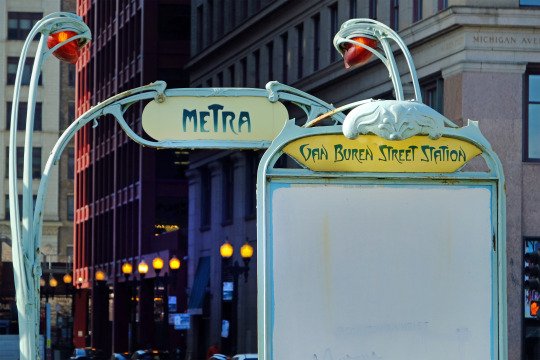
One of the station's entrances is a replica of an Hector Guimard-designed, Art Nouveau-style Paris Métro entrance. The entrance was given to Chicago as a gift by the city of Paris in 2001. The Guimard entrance will be relocated as part of a station renovation to be completed by 2027.
The station was originally constructed by the Illinois Central Railroad (incorporated 1836; operated independently until 1972), and completed in 1896.

Vintage view of the station, with buildings of Michigan Avenue behind.

"Lake Front Improvement No. 98. Van Buren St. Station and Viaduct. Looking N. from E. end Harrison St. viaduct."
The Van Buren Station is the first Metra stop south of the Millenium Station, the northern terminus of the South Shore Line.
The station is completely invisible from the street, constructed below grade, one level below Grant Park. From Michigan Avenue, passengers descend stairs to a long, featureless tunnel about a block long, which splits into up and down ramps that easily confuse the visitor, and are inadequately labeled for the ticket office and main level, or down toward Platform 2 access.
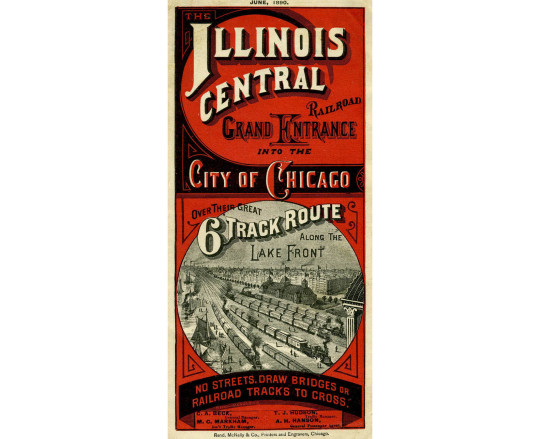
I saw the Van Buren Street Station for the first time when I took a train to Hyde Park, and decided not to depart from Millenium Station, which can be a confusing space to navigate. Nothing prepared me for this underground slice of history, and its largely intact tile and terra cotta waiting areas.

The station is below the level of the park, only its roof surrounded by a balustrade visible from above. The pedestrian viaduct over its center leads to the eastern side of Grant Park and the Lincoln statue. Entrances are from the sidewalk on the west side of Michigan Avenue, and from the Guimard Paris metro and stairs at "Van Buren Entrance" in the screencap above.

The station's placement is illustrated in the above plan, in The Inland Architect and News Record, Vol. XXIX No. 1, February 1897, Special Supplement p. 2.

The station's plan (above) and section (below) were also reproduced in the 1897 Inland Architect.
"Francis T. Bacon was the supervising architect of the Illinois Central Railroad system from the mid-1890s until 1907. Bacon died in Chicago on June 18, 1909, at the age of 43, after having been in private practice for two years." - Wikipedia entry
The Engineering Record, Building Record and Sanitary Engineer, Volume 60, 1909, cited in the wikipedia entry, doesn't reveal any further details of his life.

In this section, the station wall is heavily buttressed on the left, under the ground of Grant Park. A balustrade surrounds the ground-level roof, and the train platform is at right.

A glowing contemporary description of the station from The Inland Architect details the Waiting rooms' features and construction materials:
After passing the ticket inspectors, those taking express trains turn to the right and those for local trains to the left, in the central distributing corridor. From this corridor the passengers are ushered into two magnificent waiting rooms, each 34 feet by 106 feet and 9 ½ feet high. These rooms, for beauty, substantiality and completeness of appointments and conveniences, will compare favorably with those of any railway station in the world, even though naturally restricted in height of ceiling. The floors of the wating and toilet rooms, also corridor, are all paved with English floor tile; the foyer, vestibule and south entrance are paved with ceramic mosaic, and the bas throughout is of polished Tennessee marble. The walls are faced with Maw’s écru glazed tile, 3 by 6 inches, patented lock back, and the ceilings are of cast plates of stucco, forming a design of Gothic tracery. The cornices and girders and also finished in stucco, the point of junction with the glazed tile walls being covered with a mahogany molding. There are two rows of cast-iron columns in each room, which are incased in écru glazed terra cotta, elaborately molded and ornamented.
The windows of the ticket offices are covered with elaborate, handmade, wrought-iron grilles, some of which are polished and electroplated with bronze.
Source: The Inland Architect and News Record, Vol. XXIX No. 1, February 1897, Special Supplement p. 2

The station originally featured, apart from two waiting rooms, smoking rooms, a ladies' retiring room and lavatory, and a matron's room at the south end of the building.
The men's lavatory, bootblacking stand, toilet and janitor rooms are at the north end. There are also private lavatories for the attendants and locker rooms for the railroad employees. All these are under the space of 14 feet wide and 300 feet along the park side, and already occupied by the entrances, and are lighted through ceilings of cast iron and glass.
Source: The Inland Architect and News Record, Vol. XXIX No. 1, February 1897, Special Supplement p. 2

The tiles on the walls were manufactured by Maw & Co., of Shropshire, England, and are supplied and set by their agents, Hawes & Dodd, of this city, and are chiefly remarkable for their evenness of color, highly finished glaze, and freedom from the technical fault known as "Crazing."
Source: The Inland Architect and News Record, Vol. XXIX No. 1, February 1897, Special Supplement p. 2
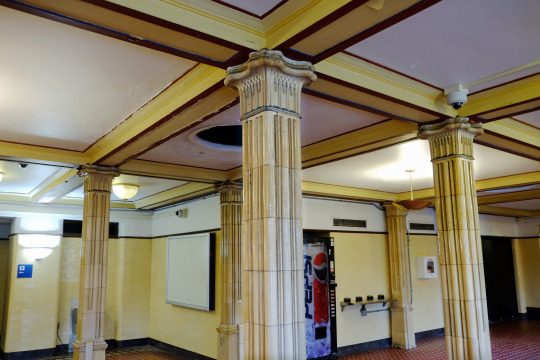
The Inland Architect article also noted the building's fireproof construction, including terra-cotta-clad iron columns, and that the entire interior was washable.
Not all of the station's original features remain. The cast-plaster ornamental ceiling is long gone, as are some of the more elaborate decorative elements, such as scrolled wall brackets and an ornamental drinking fountain shown in a period photo below.

No trace remains of the original marble and bronze recessed drinking fountains or decorative brackets above.

The column bases and bright inlaid flooring, in need of some restoration, are still in place.

The tilework remains intact, but the original ornamental ceiling has been replaced, as well as some other decorative elements.

Original mahogany waiting-room furniture includes this curved corner bench. The benches have brass feet, to facilitate cleaning the floors.

Detail of ornamental floor tile work at the edge of one waiting room

The ticket windows are located in the entrance vestibule leading to the twin waiting rooms.

Van Buren Street Station in 1907; exit stairs from middle platform to the Van Buren viaduct

"The east front of the building, 300 feet in length, shows a wall of one story, faced with cut Bedford stone - pierced with windows and doors." (Inland Architect)
The original awning over the platform was replaced, and is in a state of disrepair.
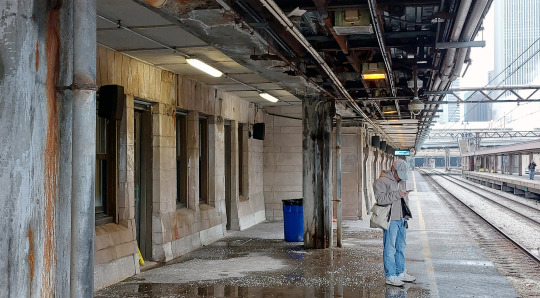
The recessed central area of the platform is directly underneath the Van Buren viaduct above.

The exterior still features carved stone decorations.
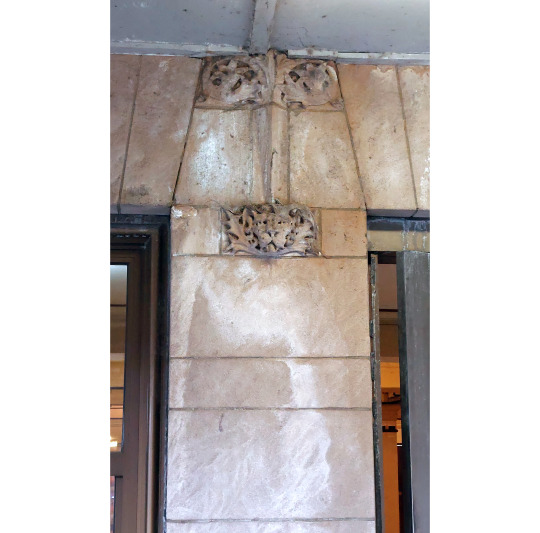
Detail of one of the carved stone elements.

"...even the copper down-spouts and their open heads are veritable works of art." ( Inland Architect)

At the far north end of the second platform, stairs allow passengers to exit to the Jackson Blvd. overpass, just south of the Art Institute.
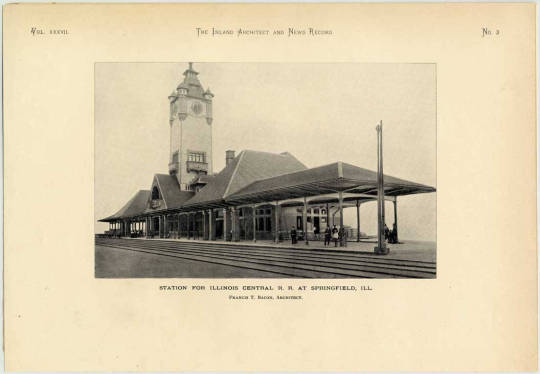
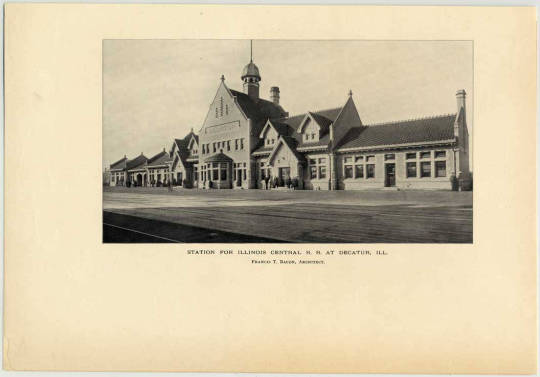
Other Illinois stations designed by Francis T. Bacon:
Left:
Illinois Central (IC) Railroad Station, Springfield, Illinois; Springfield Union Station, 500 E. Madison St., 1896-98; 1901 view, The Inland Architect
Right:
Illinois Central (IC) Railroad Station, Decatur, Illinois, c. 1890s; View 1901, The Inland Architect

The center or second platform gives access to northbound trains. It's reached by stairs or elevator below the main station.
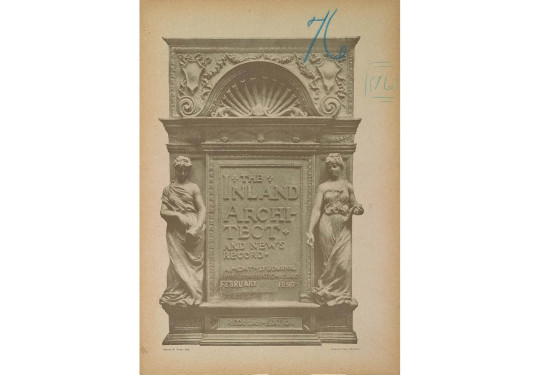
Click here for a PDF version of The Inland Architect v 29 no 1 of Feb. 1897 article on the Van Buren Station.
Links:
6 notes
·
View notes
Link
NEW YORK FOLKLORE QUARTERLY Vol. XXIX, No. 4, December 1973
WASHINGTON IRVING AND NEW ENGLAND WITCHLORE James W. Clark, Jr.
Preview Listed on the site:
NOTE: full article is a very reasonable 3 bucks, so get it.
ASSISTED by Diedrich Knickerbocker, Washington Irving consciously uses the witchlore of colonial New England in three works. The most elaborate appropriation may be found throughout “The Legend of Sleepy Hollow” (1820), in the character as well as in the frequently alluded to story matter of Ichabod Crane. But there are debts also in Knickerbocker’s History of New York (1809) and “The Devil and Tom Walker” (1824). Since one of the customary narrative strategies of Knickerbocker is to ridicule the New England region and its stock characters, it is interesting to see how he employs the seventeenth century witchcraft cases as a Puritan regionalism. More significant, though, is Irving’s introduction of New England witchcraft into the subject matter of imaginative American literature through his old Dutchman and Ichabod Crane.
Whatever the design of oblivion into which Ichabod passed from Sleepy Hollow, his disappearance has generally been seen as the end of his brief courtship of Katrina Van Tassel and the cause of the exceedingly knowing looks and bursts of hearty laughter from Brom Bones, who courted Katrina successfully. But with the removal of Crane, his ability as a storyteller was also silenced along the Hudson. Never a lover, at least not suitable to a woman whom Brom also desired, Ichabod was hardly more suited to being a teacher, singing master, or dancer. In the oral tradition, however, he was successful, with the men as well as with the women — excluding, perhaps, Brom and Katrina....
#WASHINGTON IRVING AND NEW ENGLAND WITCHLORE#folklore#witch#witch-lore#1973#By James W. Clark Jr.#NEW YORK FOLKLORE QUARTERLY#December 1973#Vol. XXIX No. 4#tags preserved for commentary of OP
1 note
·
View note
Text
BTS as Florida man headlines master post
The OP that inspired it all
Vol I Vol XXVI Vol LI Vol II Vol XXVII Vol LII Vol III Vol XXVIII Vol LIII Vol IV Vol XXIX Vol LIV Vol V Vol XXX Vol LV Vol VI Vol XXXI Vol LVI Vol VII Vol XXXII Vol LVII Vol VIII Vol XXXIII Vol LVIII Vol IX Vol XXXIV Vol X Vol XXXV Vol XI Vol XXXVI Vol XII Vol XXXVII Vol XIII Vol XXXVIII Vol XIV Vol XXXIX Vol XV Vol XL Vol XVI Vol XLI Vol XVII Vol XLII Vol XVIII Vol XLIII Vol XIX Vol XLIV Vol XX Vol XLV Vol XXI Vol XLVI Vol XXII Vol XLVII Vol XXIII Vol XLVIII Vol XXIV Vol XLIX Vol XXV Vol L
BTS as Florida man: A Christmas Special
Kim Namjoon as Florida man
BTS as Florida man: Wholesome edition
#bts as florida man#tfw you started with roman numerals thinking you weren't going to make that many posts and now here we are ;.;
268 notes
·
View notes
Text
“Terror is signaling, sir. Captain Crozier requests an ice report.”

Is he? Let’s have a look at those flags. They do seem to say “Ignorance of the ice” i.e a request for an ice report. Just another example of the details hidden in this show.
The flags look like Marryat's, which was a flag system used primarily for commercial vessels. The flags represented numbers and the numbers could correspond to ship names, geographical locations, sentences or words. These were all listed in the Marryat’s signal book (bibliography under the cut).


Note: TE stands for Telegraph, seems to indicate the start of new number sequence
Problem: The British Royal Navy used the Popham’s system which was invented in the late 1700′s and most famously used by Nelson at Trafalgar (”England Expects That Every Man Will Do His Duty”). I would expect Terror and Erebus to use that system not Marryat’s. However, I could not find the revised Popham’s from the 1820′s for comparison. It definitely does not appear to be the 1806 version. Anyone with expertise here, please chime in!
Fun fact: Marryat’s code for Terror was 241, Erebus was 694
Works consulted:
Universal Code of Signals https://books.google.com/books?id=jGEBAAAAQAAJ&printsec=frontcover&q=#v=onepage&q&f=false
British Flags: Their Early History, and Their Development at Sea; with an Account of the Origin of the Flag as a National Device By W. G. Perrin https://www.gutenberg.org/files/46370/46370-h/46370-h.htm#Chapter_VIc
Admiral Popham Telegraph Signal Book 1806 (actually someone's MS Word transcription thereof- bless) http://3decks.pbworks.com/f/Admiral%2520Home%2520Popham%2520Telegraph%2520signal%2520book%2520Final%2520edition.pdf
Signals and Instructions 1776-1794 : with addenda to vol. XXIX / edited by Julian S. Corbett. Great Britain. Royal Navy Navy Records Society, 1908.
Midshipmen and Quarterdeck Boys in the British Navy, 1771-1831 S. A. Cavell Copyright Date: 2012 Published by: Boydell & Brewer, Boydell Press
231 notes
·
View notes
Text
The small central European state of R-------- is notable for, among other things, having the second-longest post-Cold War tenure by any head of government (behind Belarus), albeit by very different from normal means. The Prime Minister of R, who so far as anyone can tell has never resorted to rigging and election or intimidating any opponents, has held office continually since the first democratic elections by, essentially, standing for nothing. Whichever way the wind blows, there the Prime Minister stands, as firmly as possible--being not merely fickle and unprincipled, but willing to commit with total vigor to the latest whim of R’s electorate. An example will serve to describe the trend:
In 1997, as the liberalization of R’s economy proceeded in the wake of the liberalization of its political system, polls consistently showed that the voters of R tended to look quite unfavorably on certain highly visible aspects of the new capitalist economy. It was not so much the end of socialism that upset them (R managed the transition better than most), but how ugly the new capitalist prosperity seemed. After all, R was a country that had, until the deposition of the last Prince in 1937, been nearly isolationist; even in the 60s it remained an agrarian backwater, its role in the Warsaw Pact being relegated mostly to supplying small amounts of garden vegetables and timber. Even though R had rapidly industrialized in the 70s and 80s, it retained a very nearly medieval aesthetic spirit, preferring simplicity and humility to ostentatious displays of plenty. Strong branding, marketing campaigns, advertising of any kind--all were anathema to the newly-minted Consumers of R, even if the products themselves were widely agreed to be superior to the old secondhand Soviet imports.
Rather than try to convince the consumers of R to change their tastes--the Prime Minister has never been a leader in that sense--the parliament simply proposed to pass a new law: all advertising of any kind in R would be banned. This was a wildly popular move; the government’s approval rating, already high, rose another five points overnight, before any of the details of the implementation were worked out. And these details proved tricky: what constituted “advertising”? What about merely designing your product to stand out on the shelf? What agency would enforce this?
In the end, after many, many committee meetings, a National Institute of Packaging Standards was established, and was given the authority to regulate standardized packaging for every conceivable kind of product sold in R, from frozen pizzas to industrial machinery. It decreed the placement on the packaging of the product name (any of the 23 Cyrillic letters normally used in R, capitals only, with single medial spaces permitted), the font, the color (invariably monochrome, from one of a list of sixty-four shades), even the materials used. Anything not covered by the regulations of the Institute simply could not be sold. The international companies attempting to expand into R howled in protest; many said they simply would not trade in R. R’s government looked with hesitation to the voters, who merely shrugged; so much the better, popular opinion seemed to think, for native industry. Domestic companies tried to evade the spirit of the law, while conforming to its letter; but after a company tried to name its appliance A A A A A MOST EXCELLENT MICROWAVE A A A A and was heavily sanctioned, most accepted that the standards authority was neither stupid, nor particularly indulgent of tomfoolery.
If anything, the 1997 law only strengthened a latent cultural antipathy toward anything that seemed to unduly demand the average citizen’s time or attention. This was a country where the telephone was not introduced until the 1940s, because of its obnoxious ring; where door-to-door solicitation was seen as only a little less of an outrage against common decency than murder. When the internet came in full force to R, a miniature version of the Great Firewall was built that acted as an adblocker for the entire country. Cold calls by telemarketers are still, in theory, punishable by jail time. If this resentment of some of modern capitalism’s most basic presence in life has stunted R’s economic growth, its people seem not to mind too much. R lurches onward into the 21st century, steered in whatever direction its people wish to go by its utterly unprincipled leader.
--Basil Twickham, A History of Europe’s Least Significant States, vol. XXIX (Oxford University Press, 2019)
59 notes
·
View notes
Text


vol. XXIX x vol. XLIX.
Bleach [ブリーチ]
#vol 29 quite screams grimmichi#bleachdaily#bleach!!edit#bleachedit#bleach#ブリーチ#tite kubo#kubo tite#ichigo kurosaki#kurosaki ichigo#bleachgraphics#bleachgraphic#Dailybleach#Fyeahbleach#grimmichi#bleach grimmjow#grimmjow jaggerjack#grimmjow x ichigo#grimmjow jaegerjaquez
69 notes
·
View notes
Text
Abkhazians & Ossetians in Georgia. A Short History
In light of the disinformation campaign carried out by Russian information networks and picked up by western media, the Institute of the Georgian History at Ivane Javakhishvili Tbilisi State University has released an explanation as to why the Abkhazia and Tskhinvali regions (incorrectly called "South Ossetia") have always been an integral part of Georgia.
In the remote past, to the south of the Great Caucasian Range and east of the Black Sea, rural clans fought each other for land and mines, making alliances and early states. Two cultures equipped first with bronze and then with iron were established in the valleys of the rivers Rioni (Phasis), Chorokhi (Aphsaros), and Mtkvari (Cyros/Kura). Roughly, the borders of Colchis included the city of Pitius (Bichvinta, Pitsunda) in the North West, Sarapanis (Shorapani) in the East, near the Likhi mountains, which divides Georgia into West and East, and the mouth of the river Chorokhi in the South, near Batumi, Georgia’s main port. Another name for Colchis is Egrisi, derived from the tribal name Margali/Megreli/Mingrelian. The Mingrelian language, very close to the Georgian, is still spoken in West Georgia as a family one, like that of West Georgian highlanders, the Svani. The next country had two rivers, Chorokhi, now mostly in Turkey, and Mtkvari within its borders. Local folk called it Kartli, and the Greeks – Iberia and Iberians. The latter term contributes to Ivirk, Vrastan – Armenian terms; also to Varkan, Gurgan, Gurgistan – Persian terms, which in turn contributes to Georgia and Gruziya.
Thus, Kartli, while comprising the Mtkvari and Chorokhi valleys, was labeled as Iberia, or Vrastan, or Varkan, or Gurgan by foreigners. Gradually, Colchis/Egrisi and Kartli/Iberia became more and more integrated, and Georgian, the language spoken in Kartli, spread to the eastern Black Sea coast, putting the Mingrelian and Svani languages in the position of a family language. From that point on, this new country was called Sakartvelo, a term derived from Kartli, and also Iberia, Gurgistan, Gruziya and Georgia (T. Dundua. History of Georgia. Tbilisi. 2017, pp. 5-22. v. Academia.edu/Tedo Dundua).
Still, there was another language in West Georgia which was also converted into a family language: Abkhazian. The Autonomous Republic of Abkhazia (Georgia) has Sokhumi as its capital. Sokhumi is the Turkish version of the Georgian name Tskhumi, while the Greeks and Italians called the city Dioscurias and Sebastopolis. People living in its neigborhood in the Classical and Hellenistic periods were the Colas and the Coraxae, obviously Colchian clans. Their names are substituted by that of the Colchians themselves. The first mention of the Aphsils, obvious ancestors of the Abkhazians, near Sebastopolis/Tskhumi, dates back to the 70s of the 1st c. A.D. Soon, their relatives, the Abasks, appear. These two names sometimes disappear in favor of “Lazi,” the name of Mingrelian-speaking people descended from the southern mountains to mingle with the Colchians, thus changing the name of the country into Lazica. In the northern part of Lazica under the local feudal lords, they again call themselves Aphsils and Abasks, when unified with the rest of the country – Lazi. That means that from the 2nd c. A.D., the Mingrelian language was a social one throughout Lazica, while the Abkhazian language was put in the position of a family language spoken near Sebastopolis/Tskhumi. Indeed, the special Mingrelian term for that part of Lazica was “apkha,” i.e. periphery. The periphery of what? That of Mingrelian, i.e. western Georgian, culture. Gradually, Aphsils and Abasks under the local princes also started to call themselves Abkhazians. When in the 8th c., apparently through marriage, their prince found himself residing in the central city of Kutaisi, Lazica/Egrisi received one more name – Apkhazeti. With the Georgian language becoming dominant on the eastern Black Sea coast, the Mingrelian, Svani and Abkhazian languages found themselves in the position of a family language (T. Dundua. Christianity and Mithraism. The Georgian Story. Tbilisi. 1999, p. 6; T. Dundua, Akaki Chikobava. Pacorus, the Lazi King, Who Was Overlord of Colchis/Western Georga. Tbilisi. 2013, pp. 9-16; T. Dundua. Georgia within the European Integration. Tbilisi. 2016, pp. 81-88. v. Academia.edu/Tedo Dundua).
West and East unified was called Sakartvelo/Georgia. And the title of the kings from the Bagrationi ruling dynasty was as follows: “King of the Abkhazians (i.e. Western Georgia), Kartvelians (Eastern and Southern Georgia), Ranians and Kakhetians (extreme East of the Eastern Georgia)” (T. Dundua. Review of Georgian Coins with Byzantine Iconography. Quaderni ticinesi di numismatica e antichità classiche. Lugano. 2000. Vol. XXIX, pp. 389-393; T. Dundua and Others. Online English- Georgian Catalogue of Georgian Numismatics).
The decline of Georgia towards the end of the 16th c. enabled the Ottomans to increase their territory, seeing them taking control of the cities on the eastern Black Sea coast. Georgian frontier defenses were down. Finding so little opposition, many tribes settled in the districts they had penetrated, a new wave of the Abkhazian speaking clans among them. They made their way from the mountains first to the region of nowadays Sochi (Russian Federation), and then down the coast towards Bichvinta (Pitius, Pitsunda). Those rough highlanders forced part of the local agricultural folk to flee to the central regions. Thus, rural and urban sites suffered much and the links with the rest of the country were badly damaged. The Ottoman overlords also encouraged the slave trade, completely changing the economic visage of the northwest of western Georgia for centuries before the Russians advance against the Ottomans in the 19th c. (T. Dundua. North and South (towards the Question of the NATO enlargement). www.nato.int/acad/fellow/99-01/dundua.pdf, pp.41-42; T. Dundua and Others. The Black Sea – Zone of the Contacts. Tbilisi. 2001, pp. 9-10, 15-16; T. Dundua and Others. The Black Sea. A History of Interaction. Teaching Pack. The Council of Europe. Oslo. 2004, pp. 46, 105. v. Academia.edu/Tedo Dundua).
The Russian Empire annexed eastern Georgia, the Kingdom of Kartli-Kakheti, in 1801. This paved the way for Russian expansion into western Georgia. In 1810, Abkhazian prince Giorgi (Safar Beg) Shervashidze swore allegiance to the Russian Emperor and in 1864, Russian governance was established in the territory. (Abkhazia in the late 18th- early 19th centuries. Entry of Abkhazia Under the “Protection” of Russia. in Essays from the History of Abkhazia. Tbilisi. 2011, pp. 300-305). Sukhumi military department was founded (M. Lordkipanidze. The Abkhazians and Abkhazia (Georg., Russ. and Engl. texts). Tbilisi. 1990 http://www.amsi.ge/istoria/div/m.lordkiPaniZe_afx.html#90).
Although the process of separating Abkhazia from Georgia was actively supported by the Russian authorities, still Abkhazia was a natural and integral part of Georgia. Perhaps it was for this reason that the Sukhumi military district was soon included in the Kutaisi governorate. Despite the negative effects of the Russian imperial policy, in 1918, the year when the Democratic Republic of Georgia was founded, Abkhazia was a part of Georgia (M. Lordkipanidze. The Abkhazians and Abkhazia (Georg., Russ. and Engl. texts). Tbilisi. 1990 http://www.amsi.ge/istoria/div/m.lordkiPaniZe_afx.html#90).
On June 11, 1918, an agreement was signed between the people’s council of Abkhazia and the leadership of the Democratic Republic of Georgia, where Abkhazia as a part of Georgia gained autonomy.
After the end of Georgia’s short independence in 1921, Abkhazia remained within Soviet Socialist Republic of Georgia under a special union agreement, as a treaty republic having a certain type of autonomy within Georgia. In 1931, Abkhazia officially became the Autonomous Soviet Socialist Republic (ASSR) of Georgia (Political Status of Abkhazia within the Soviet Georgia. 1921-1937. in Essays from the History of Abkhazia. Tbilisi. 2011, pp. 419-436; Революционные комитеты Абхазии в борьбе за установление и упрочение Советской власти. Сборник документов и материалов. Сухуми. 1961, p. 350). This remained unchanged until the end of the Soviet Union. According to the 1989 Soviet census, the total population on the territory of the ASSR of Abkhazia was 525,061, of which 239,872 were ethnic Georgians (45.7% of the population), while 93,267 were Abkhazians (17.8%) (S. Markedonov. Abkhazia: Historical Context. in Abkhazia Between Past and Future. Prague. 2013, p. 18).
Abkhazia enjoyed cultural and scientific benefits as part of Georgia during the Soviet era. The Abkhazian language was taught at the schools, and university.
Since 1993, the Autonomous Republic of Abkhazia has been occupied by the Russian Federation (for the full-length narrative about Abkhazians v. З. Папаскири. Абхазия: история без фальсификации. 2е изд. Тбилиси. 2010 (with Engl. summary).
The next region occupied by the Russian Federation was the Autonomous District of South Ossetia. The Ossetians started settling in Georgia beyond the Caucasian range in the 16th-17th cc. as fugitives.
After the annexation of eastern Georgia by Russia in 1801, the Ossetian villages were attached to the Gori district of the Tbilisi governorate.
In 1920, the Russian Bolsheviks supported Ossetians living in the Democratic Republic of Georgia, in the mountains north of Gori, to establish the Soviet power there and declare the territory a part of Soviet Russia. This was an abortive attempt.
In February 1921, Soviet Russia violated the agreement of May 7, 1920 by militarily attacking the Georgian state and eliminating its independence. In April 1922, the Bolsheviks granted so-called South Ossetia the status of autonomous district within Soviet Socialist Republic of Georgia. Soviet policy can be regarded as a premeditated attempt to disrupt the future attempts of the Georgians to gain independence and build a stable state as separatism within Georgia would constrain Tbilisi in its actions. The Autonomous District of South Ossetia consisted of a number of Ossetian settlements and a purely Georgian town Tskhinvali.
Thus, in 1922, the Autonomous District of South Ossetia was created in the heart of historic Georgian lands where the Georgian population represented the majority of the population.
It also needs to be emphasized that throughout the Soviet period (until 1991), the Ossetians living in Georgia were granted all necessary legal rights as an ethnic minority. Then Georgia became independent and the Russian occupation of the Autonomous District of South Ossetia began. (M. Lordkipanidze, G. Otkhmezuri. Ossets in Georgia. in The Caucasus and Globalization. Vol. 1 (4). Tbilisi. 2007, pp. 109-118; R. Topchishvili. Ethnic Processes in Shida Kartli (the Ossetians in Georgia). in Causes of War – Prospects for Peace. Georgian Orthodox Church. Konrad-Adenauer-Foundation. Tbilisi. 2009, pp. 111-138).
Prof. Dr. Tedo Dundua is the Director of the Institute of Georgian History, Faculty of Humanities, at the Ivane Javakhishvili Tbilisi State University.
By Prof. Dr. Tedo Dundua & Dr. Emil Avdaliani
Photo: Map of Georgian states in 1762. Based on the map of Dr. Andrew Andersen, from Atlas of Conflicts. Author: Gaeser
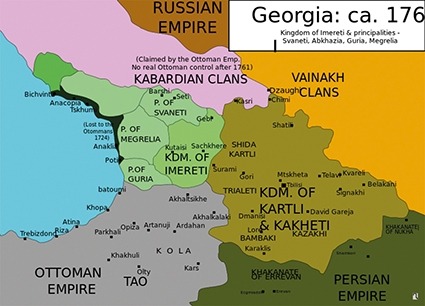
#history#academia#Georgia#abkhazia#ossetia#sakartvelo#early modern europe#easterneuropeanhistory#society#migration#warzone
15 notes
·
View notes
Text
subfluences, of
ploughs expansive sheets of flame, subfluence of the beaming sconce! — limely waving 1 useful for reference, subfluence of whom the exquisite portrait, join the following list 2 subfluence of loss 3 long under the in when mixture containing organic subfluence of 4 I’d like to know the subfluence of the fairies differences of opinion about in employment of the word 5 enterprise, and subfluence of 6 conversation to another subfluence of 7 distance as to be entirely out of the ínspire of the long wire this arrangement is subfluence of 8 subfluence of chlorómethy ! and 9 if not subfluence of slavery 10 Pages could be written upon the subfluence of water, its importance waters 11 subfluence of a large proportion of the lands 12 Therapeutical subfluence of 13 temptation to be subfluence of 14 an answer. The cause was subfluence of 15 sum and subfluence and suggestion of 16 What processes here occur, accompanying reactions take place and the and which take place especially under the in-intensity of attraction which these other subfluence of light 17 the in of books on the ever-expanding subfluence of the far 18 subfluence of a periscope 19 subfluence of style was distinctly jagged pseudo-geometrical slack 20 the azoted subfluence of 21 subfluence of “Some English and Old French forms a volume of Phrases” 22 subfluence of those decisions 23 subfluence of rays 24
sources (all OCR cross-column misreads/confusions)
1 ex The Universal Magazine v.14 (1754) : 6 preview snippet, evidently from “A descant upon creation” by James Hervey (1714-58 *), found at his Meditations and Contemplations. In Two Volumes... (London, 1796) : 151 2 ex “Biographical Particulars of Celebrated Persons Lately Deceased,” here involving The Rev. Mark Noble and John Fleming, late Lord de Tabley, in The New Monthly 21 (August 1, 1827) : 350 3 ex E. Bellchambers, A General Biographical Dictionary : Containing Lives of the most emininent persons of all ages and nations. Vol. 4 (of 4; London, 1835) : 252 involving entries for Conrad Vorstius (“an eminent divine”; 1569-1622) and Gerard John Vossius (poet, philologist, professor of rhetoric and chronology; 1577-1649) 4 entry for “toxicology” by James Apjohn (1796-1886 *), in The Cyclopaedia of Practical Medicine Vol. 4 (SOF — YAW) Supplement (London, 1835) : 189-243 (214) 5 ex T. F., “Familiar Epistles from Ireland, Letter the Fourth, from Terence Flynn, Esq. to Dennis Moriarty, Student-at-Law, London.” in Fraser’s Magazine 42 (September 1850) : 319-328 (327) 6 ex Archibald Alison, History of Europe from the Commencement of the French Revolution in 1789 to the Restoration of the Bourbons in 1815. Ninth edition, vol. 12 (Edinburgh and London, 1855) : 50 7 ex John Flesher, ed., Arvine’s Cyclopaedia of Moral and Religious Anecdotes : A collection of nearly three thousand facts, incidents, narratives, examples, and testimonies... the whole arranged and classified on a new plan, with copious topical and scriptural indexes. (London, 1859) : 23 a later edition and who was Arvine? *Kazlitt Arvine, name originally Silas Wheelock Palmer, changed by Mass. leg. while at Newton, b. Centerville, N.Y., Dec. 18, 1819. Wes. U. 1841; N.T.I. 1842-45; ord. Nov. 6, 1845; p. Woonsocket, R.I., 1845-47; Providence ch., New York, N.Y., 1847-49; West Boylston, Mass., 1849-51; author, Cyclopedia of Moral and Religious Anecdote, 1848; a volume of poems; sermons; d. Worcester, July 15, 1851. ex The Newton Theological Institution, General Catalogue, Eleventh Edition (Newton Centre Massachusetts, April 1912) : 56 8 ex entry (by Joseph Henry, of the Smithsonian Institution) for “Magneto-Electricity” in George Ripley and Charles A. Dana, eds., The New American Cyclopaedia : A popular dictionary of general knowledge, Vol. 11 (MacGillvray-Moxa). (New York, 1861) : 67-72 (69) 9 ex letter to the editor on the topic of Bichloride of Methylene (from A. Russell Strachan), in The Medical record : a semi-monthly journal of medicine and surgery (March 2, 1868) : 22 on mixture of alcohol, chloroform and ether, see wikipedia 10 ex “Slavery,” in The Complete Works of W(illiam). E(llery). Channing: With an Introduction (London, 1870?) : 570-615 (591) on Channing (1780-1842), consult wikipedia 11 ex Charles McIntire, Jr., “Science in Common Things,” in Our Home: A Monthly Magazine (Devoted to Local and General Literature) 1:6 (Somerville, N.J.; June 1873) : 247-250 12 ex History of Summit County : With an Outline Sketch of Ohio. Edited by William Henry Perrin. Illustrated. (Chicago, 1881) : 280 13 ex Edwin J. Houston. A Dictionary of Electrical Words, Terms and Phrases, second edition, rewritten and greatly enlarged. (New York, 1892) : 200 14 ex John Brooks Leavitt. “On the Administration of Justice,” in The Counsellor : The New York Law School Law Journal 2:4 (January 1893) : 101-108 15 ex Birmingham Mineral R. Co. v. City of Bessemer (Supreme Court of Alabama. July 27, 1893), in The Southern Reporter 13 (June 14 – December 20, 1893) : 487-489 16 ex Josephine Lazarus, “Jewish Thought in Modern English Poetry : Robert Browning” in The Menorah (“official organ of the Jewish Chautauqua”) 38:1 (January 1905) : 42-53 (44) 17 snippet view only, ex Society of Dyers and Colourists, Bradford, Eng. (Yorkshire), The Journal 25 (1909) : 12 18 ex review of Joseph H. Longford, The Story of Old Japan, in The Oriental Review 1:11 (New York; April 10, 1911) : 212-213 19 ex “The Story of the Week” (involving Canadian War Graft, and The “Sussex” Question), The Independent vol 86 (April 17, 1916) : 96-99 20 ex The American Magazine of Art 8:3 (January 1917) : 118 involving “A fiction among futurists” and an obituary for Henry W. Ranger (landscape painter) 21 ex Andre Dubosc, “Application of Catalysis to Vulcanization,” in The Rubber Age 3:2 (April 25, 1918) : 78-79 22 ex XXIX. Literature and Language / Romance Languages and Literature, by George L. Hamilton, in The American Year Book : A Record of Events and Progress, 1918. Edited by Francis G. Wickware... with coöperation of a supervisory board representing national learned societies (New York, 1919) : 778 23 ex Thomas v. Little et al. (June 7, 1923) in Reports of Cases Argued and Determined in the Supreme Court of Alabama Vol. 209 (1923) : 590-592 24 snippet view, ex International Labour Office, Occupation and Health: Encyclopedia of Hygiene, Pathology, and Social Welfare 2 (1934) : 417
—
2 of n
5 notes
·
View notes
Text
☾ 𝔙𝔦𝔬𝔩𝔞𝔱𝔢𝔡 𝔥𝔬𝔩𝔦𝔫𝔢𝔰𝔰 ☽
• 𝕌𝕟𝕒 𝕧𝕚𝕤𝕚𝕠́𝕟 𝕖𝕢𝕦𝕚𝕧𝕠𝕔𝕒𝕕𝕒 𝕕𝕖 𝕁𝕦𝕕𝕒𝕤 •
𝓓𝓾𝓮𝓷̃𝓪𝓼 𝓗𝓮𝓻𝓷𝓪́𝓷𝓭𝓮𝔃 𝓐𝓷𝓷𝓮𝓴𝓮
Para entender un poco mejor mi interés e inspiración necesito dar un contexto mas o menos claro el cual hasta hace poco yo también pude entender: Cuando mi madre cayó gravemente enferma hace ya seis años, la idea de un acercamiento religioso de su parte estuvo bastante presente junto a nosotros sus familiares como un intento de consuelo de ambas partes (la familia y los sacerdotes, pastores y demás gente que logró entrar a nuestro hogar). En general era bastante confuso pero nunca incomodó. Incluso podría considerarlo interesante y curioso, ya que cada miércoles se escuchaba en casa la palabra de un padre y cada jueves la de un pastor, e incluso, si no mal recuerdo, uno que otro fin de semana llegaba un testigo de Jehová a hablar con ella... He de admitir que casi nunca estuve presente en esas pláticas debido a la escuela, aunque de vez en cuando los encontraba y me pedían acompañarlos. En fin. La gente vino y se fue. Nos contaron de un mismo Dios con actos bondadosos pero que, a conveniencia de ellos, era totalmente diferente o divisor de las creencias con aquel prójimo que pudiese no compartir la misma religión que ellos. Repito, eso era bastante raro para mí.
Fue así que mi inspiración no vino de algo interesante o conmovedor, sino de algo incómodo de hablar y deprimente en su momento. Ahora sólo lo tomo como un aprendizaje y una excusa más para poder seguir investigando entre tantas religiones. No me limito con la judeocristiana, sinceramente, pero es la que más sé debido a estas situaciones en mi vida y de las que más me parecen interesantes por el momento. Hay mucho de donde sacar, siempre y cuando lo veas de una manera objetiva y no bajo las reglas de una doctrina.
"A veces cuando las tensiones del sobrevivir ceden, podemos de nuevo, como cuando éramos niños, empezar a contemplar lo sensible y sus estructuras como monadas sin ventanas. Los vividos y radiantes valores de lo sensible se gozan entonces por si mismos, satisfaciendo una necesidad primordial fundamental".
Este camino entre el arte y religión puede explicarse de una forma más sencilla con una sola palabra: Sufismo. Pero, ¿qué significa?
El término Sufismo (صوفية), se define como un conjunto de hábitos de tipo religioso que se caracteriza por hacer hincapié en ciertas ceremonias, con el fin de servir como orientación para aquellos individuos que buscan un encuentro espiritual con Dios. El profeta Mahoma es el mayor representante de éste.
¿Qué es sufismo? Su definición y significado. (2017, 26 mayo). Concepto Definición. https://conceptodefinicion.de/sufismo/
Explicado de otra manera, se trata de un camino, de una experiencia o un proceso de aprendizaje, así que sólo podemos saber sobre algo al experimentarlo y vivirlo en carne propia, ya que por más que muchos nos lo intenten explicar, no será lo mismo al vivir la experiencia real. Y si bien es vista como el inicio del camino a la religión Islam, también puede verse como lo más opuesto a cualquier forma de rigidez, fanatismo o imposición. No puede haber imposición en cuestión de religión.
La explicación de la conexión entre mi contexto y el tema viene sobrando a estas alturas del blog, ya que como mencioné anteriormente, esto es resultado de una gran intriga ante distintas formas de manifestar o creer en una doctrina idealizada por el propio humano y no impartida por un Dios “bondadoso”. Con esto, dejo totalmente visible mi interés e importancia del tema hacia mi propia persona, mi curiosidad y poder así experimentar y ampliar un poco más la visión que tengo ante todo esto. También sé que esto puede interpretarse como las palabras de alguien fanático u obsesionado con el tema, a tal grado que pueden calificarme como una empedernida, pero no hay mayor satisfacción que cuestionarse lo impuesto y conocer diferentes puntos de vista hasta poder estar satisfecho con una o varias respuestas que tú mismo puedes ir descubriendo con el paso del tiempo.
Así, lo formal en esta obra es sencillo y fácil de digerir para un tema un poco complejo: la paleta de colores al ser terrosos suelen ser vistos como algo sucio, e incluso antes se podía considerar el marrón como “uno de los principales colores del mal y de lo malo, y es precisamente el hecho de salir de todas las mezclas lo que le quita personalidad y carácter.” Por ende, ayuda a señalar la pena que carga consigo Judas incluso en el arte. La imagen fue levemente distorsionada como una pequeña comparación entre lo que pudo haber sido y lo que no, así que en este caso al santificarse y ser libre de aquellas monedas de plata, se le muestra tranquilo y con los ojos cerrados como representación de un peso menos que carga con él, y todo sin olvidar aquel dedo medio levantado “discretamente” como muestra de la crítica ante sus acciones. La mano derecha tiende a ser vista como el lado terrenal del humano, así que, en este caso, el propio Iscariote juzga las creencias terrenales y no espirituales.
Hay que tomar en cuenta de que no he sido la primera ni seré la última persona interesada en el tema y la cual ha creado obras para criticar o tomar un punto de vista diferente de las religiones. Un ejemplo de ello es Paul Fryer el cual representa la muerte de Cristo esta vez por electrocución.
"La obra es una actualización de la crucifixión. Dos mil años después seguimos atando a la gente a un artilugio de madera para matarla”. A pesar de ser polémica, la obra ha dado pie a un debate positivo tanto en los círculos religiosos como en los no religiosos, tal y como explica el artista a The Creators Project: “Hubo dos personas que se pusieron a llorar ante la obra y cuando se expuso en la Cathedral of Gap en 2009, la respuesta fue increíblemente positiva. Me sorprendió porque pensé que la Iglesia Católica era más conservadora de lo que la pintaban en algunos libros los libros”.
Marks, A. M. (16-05-17). Cuando los artistas se cagan en Dios. Vice. https://www.vice.com/es/article/mg5vg8/representacion-de-cristo-en-el-arte-contemporaneo-polemica
Para ver su obra puedes dar click aquí
Un segundo artista que ha llegado a criticar la religión judeocristiana y que me resulta demasiado interesante es Russel Oliver donde “explica a The Creators Project, “The Monstrosity of Christ (La monstruosidad de Cristo) es mi crítica a la Cristiandad como culto del sacrificio humano”. “
Para ver su obra puedes dar click aquí
Un último artista que me parece totalmente fascinante y me atrapó con la idea de su obra fue Willem Zijlstra con su obra Agnus dei.
El artista explica que mientras en el acto religioso se canta al cordero de Dios que se sacrificó por nosotros, se preguntó si en la actualidad aún se comprendía esta creencia.
Para ello compró un cordero y lo filmó durante su nacimiento, su vida y mientras era sacrificado para después disecarlo y recostarlo sobre una pila de periódicos a manera de altar que tiene como eje central el encabezado “El hombre es capaz de todo’, producto de un artículo sobre el holocausto judío.
La cabeza del cordero descansa justo a lado de la imagen que ilustra la nota mostrando una imagen de judíos encerrados en los campos de concentración.
Barrientos, A. B. (26-05-25). La religión en el arte contemporáneo. Vanguardia. https://vanguardia.com.mx/articulo/la-religion-en-el-arte-contemporaneo
Para ver su obra puedes dar click aquí
Con esto y para concluir con el tema, puedo decir que el desarrollo artístico de este proyecto ha ido evolucionando de manera interesante. Tal vez no constante o lineal, pero sí de una manera que me agrada y con la que pienso seguir trabajando. Me es totalmente fascinante trabajarlo desde distintos puntos y no el de una representación literal de una figura divina impuesta, aunque he de admitir que siempre habrá detalles que se podrán desechar para una mejor calidad en el trabajo, y en este caso sería el uso constante de una paleta de colores. Me gusta demasiado trabajar con tonos rojizos y negros, pero para salir de mi zona de confort necesito arriesgarme con otros colores y tonos como lo hice en este parcial, y aunque no son de mi agrado, creo que puedo con ello.
En cuestión de los tiempos de producción y objetivos estoy satisfecha, fui constante y trabajé con calma para un buen trabajo, así que seguiré manteniendo el ritmo como hasta ahora lo he hecho.
FUENTES DE CONSULTA:
¿Qué es sufismo? Su definición y significado. (2017, 26 mayo). Concepto Definición. https://conceptodefinicion.de/sufismo/
Marks, A. M. (16-05-17). Cuando los artistas se cagan en Dios. Vice. https://www.vice.com/es/article/mg5vg8/representacion-de-cristo-en-el-arte-contemporaneo-polemica
Núñez, J. N. (2014, 22 septiembre). Psicología De Los Colores: El Color Marrón. Aprendizaje y vida. https://aprendizajeyvida.com/2014/09/22/el-color-marron/
Barrientos, A. B. (26-05-25). La religión en el arte contemporáneo. Vanguardia. https://vanguardia.com.mx/articulo/la-religion-en-el-arte-contemporaneo
Rosen, A. R. (2017, 26 marzo). ¿Amigos o enemigos? La larga y complicada relación del arte con la religión. Expansion. https://expansion.mx/estilo/2017/03/24/amigos-o-enemigos-la-larga-y-complicada-relacion-del-arte-con-la-religion
Dupre, L. D. (1975). EL ENIGMA DEL ARTE RELIGIOSO: Vol. XXIX (1.a ed.) [Libro electrónico]. The Review of Metaphysics. http://www.bdigital.unal.edu.co/30378/1/29183-104836-1-PB.pdf
2 notes
·
View notes
Photo

Plate II. K. Mitsukori: Holothurioidea. The Journal of the College of Science, Imperial University of Tokyo, Japan. vol. XXIX. 1912.
102 notes
·
View notes